ECU TOYOTA AVALON 2012 XX40 / 4.G Owners Manual
[x] Cancel search | Manufacturer: TOYOTA, Model Year: 2012, Model line: AVALON, Model: TOYOTA AVALON 2012 XX40 / 4.GPages: 580, PDF Size: 9.33 MB
Page 4 of 580

TABLE OF CONTENTSIndex
4
3-1. Using the air conditioningsystem a nd defogger
Automatic air conditioning system .............................. 228
Using the steering wheel climate control
switches ........................... 236
Rear window and outside rear view mirror
defoggers ......................... 237
3-2. Using the audio system Audio system type .............. 239
Using the radio ................... 243
Using the CD player ........... 251
Playing back MP3 and WMA discs ....................... 259
Operating an iPod .............. 267
Operating a USB memory ............................ 274
Optimal use of the audio system .............................. 282
Using the AUX port ............ 285
Using the steering switches ........................... 286 3-3. Using the Bluetooth
® audio
system
Bluetooth
® audio
system .............................. 289
Using the Bluetooth
®
audio system .................... 292
Operating a Bluetooth
®
enabled portable
player ................................ 299
Setting up a Bluetooth
®
enabled portable
player ................................ 301
Bluetooth
® audio system
setup ................................. 307
3-4. Using the hands-free s ystem
( for cellular phone)
Hands-free system (for cellular phone) ........... 308
Using the hands-free system .............................. 311
Making a phone call............ 320
Setting a cellular phone ...... 325
Security and system setup ................................. 332
Using the phone book......... 337
3-5. Using the interior lights Interior lights list.................. 346
3Interior features
Page 38 of 580
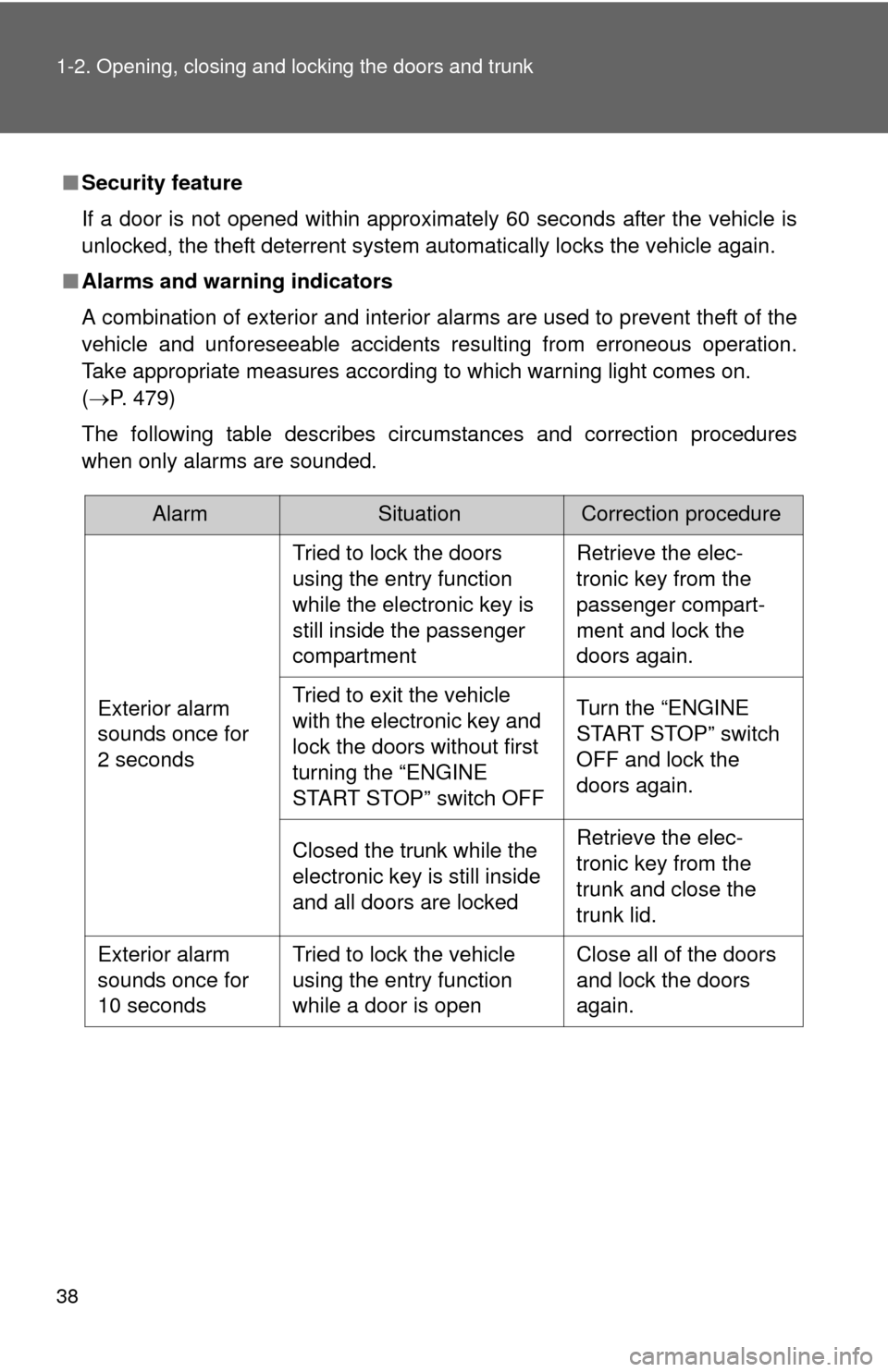
38 1-2. Opening, closing and locking the doors and trunk
■Security feature
If a door is not opened within approximately 60 seconds after the vehicle is
unlocked, the theft deterrent system automatically locks the vehicle again.
■ Alarms and warning indicators
A combination of exterior and interior alarms are used to prevent theft of the
vehicle and unforeseeable accidents resulting from erroneous operation.
Take appropriate measures according to which warning light comes on.
(P. 479)
The following table describes circumstances and correction procedures
when only alarms are sounded.
AlarmSituationCorrection procedure
Exterior alarm
sounds once for
2 seconds Tried to lock the doors
using the entry function
while the electronic key is
still inside the passenger
compartment
Retrieve the elec-
tronic key from the
passenger compart-
ment and lock the
doors again.
Tried to exit the vehicle
with the electronic key and
lock the doors without first
turning the “ENGINE
START STOP” switch OFF Turn the “ENGINE
START STOP” switch
OFF and lock the
doors again.
Closed the trunk while the
electronic key is still inside
and all doors are locked Retrieve the elec-
tronic key from the
trunk and close the
trunk lid.
Exterior alarm
sounds once for
10 seconds Tried to lock the vehicle
using the entry function
while a door is open Close all of the doors
and lock the doors
again.
Page 44 of 580

44 1-2. Opening, closing and locking the doors and trunk
■Security feature
P. 3 8
■ When the key battery is fully depleted
P. 440
■ Conditions affecting operation
Vehicles with smart key system
P. 3 4 Vehicles without smart key systemThe wireless remote control function may not operate normally in the fol-
lowing situations.
●Near a TV tower, radio station, el ectric power plant, airport or other
facility that generates strong radio waves
●When carrying a portable radio, cellular phone or other wireless com- munication device
●When multiple wireless keys are in the vicinity
●When the wireless key has come into contact with, or is covered by a metallic object
●When a wireless key (that emits radio waves) is being used nearby
●When the wireless key has been left near an electrical appliance such as a personal computer
■ Customization that can be co nfigured at Toyota dealer
Settings (e.g. 2-step unlocking function, trunk unlocking function) can be
changed. (Customizable features P. 545)
Page 58 of 580
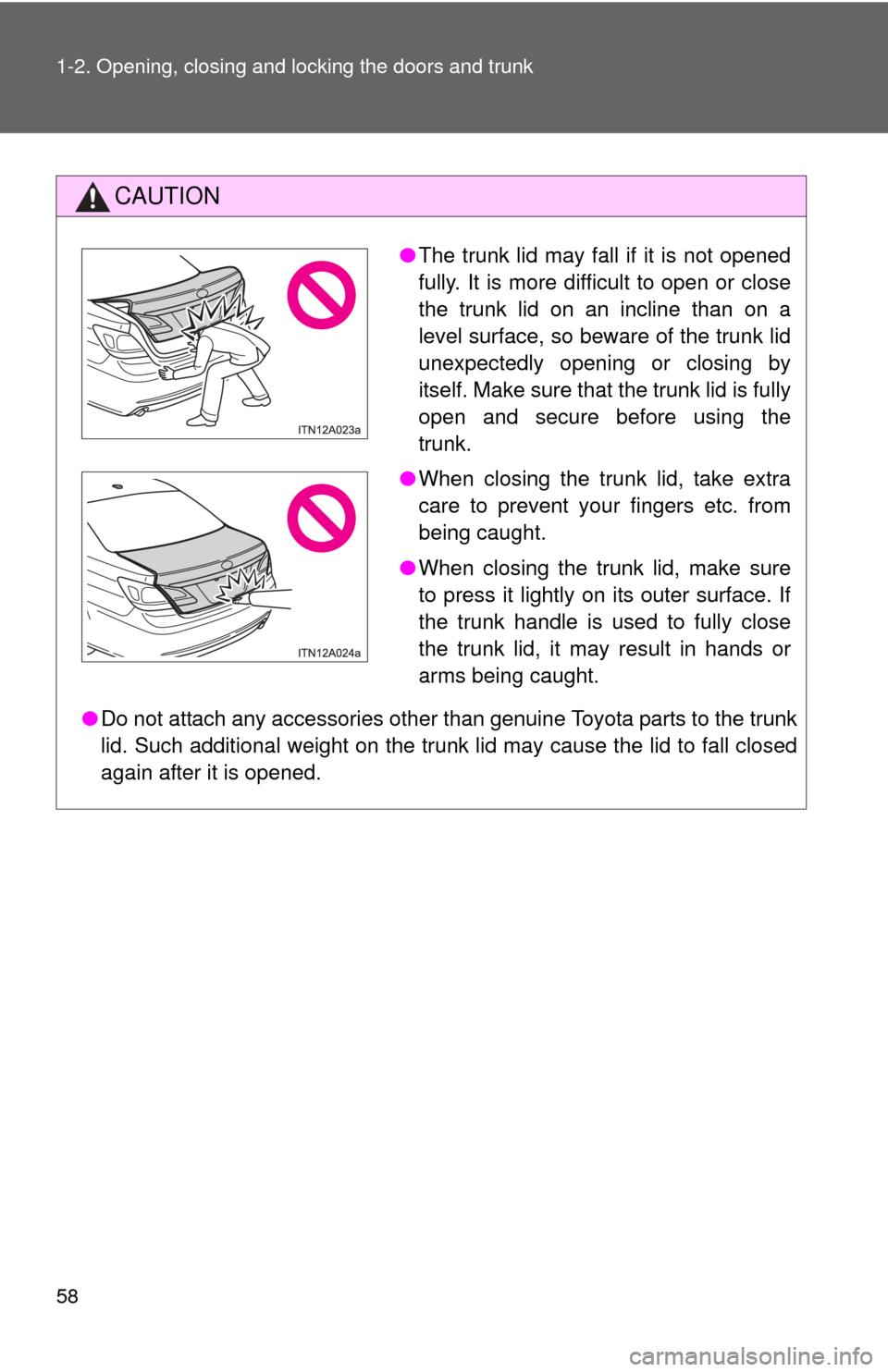
58 1-2. Opening, closing and locking the doors and trunk
CAUTION
●Do not attach any accessories other than genuine Toyota parts to the trunk
lid. Such additional weight on the trunk lid may cause the lid to fall closed
again after it is opened.
●The trunk lid may fall if it is not opened
fully. It is more difficult to open or close
the trunk lid on an incline than on a
level surface, so beware of the trunk lid
unexpectedly opening or closing by
itself. Make sure that the trunk lid is fully
open and secure before using the
trunk.
● When closing the trunk lid, take extra
care to prevent your fingers etc. from
being caught.
● When closing the trunk lid, make sure
to press it lightly on its outer surface. If
the trunk handle is used to fully close
the trunk lid, it may result in hands or
arms being caught.
Page 74 of 580
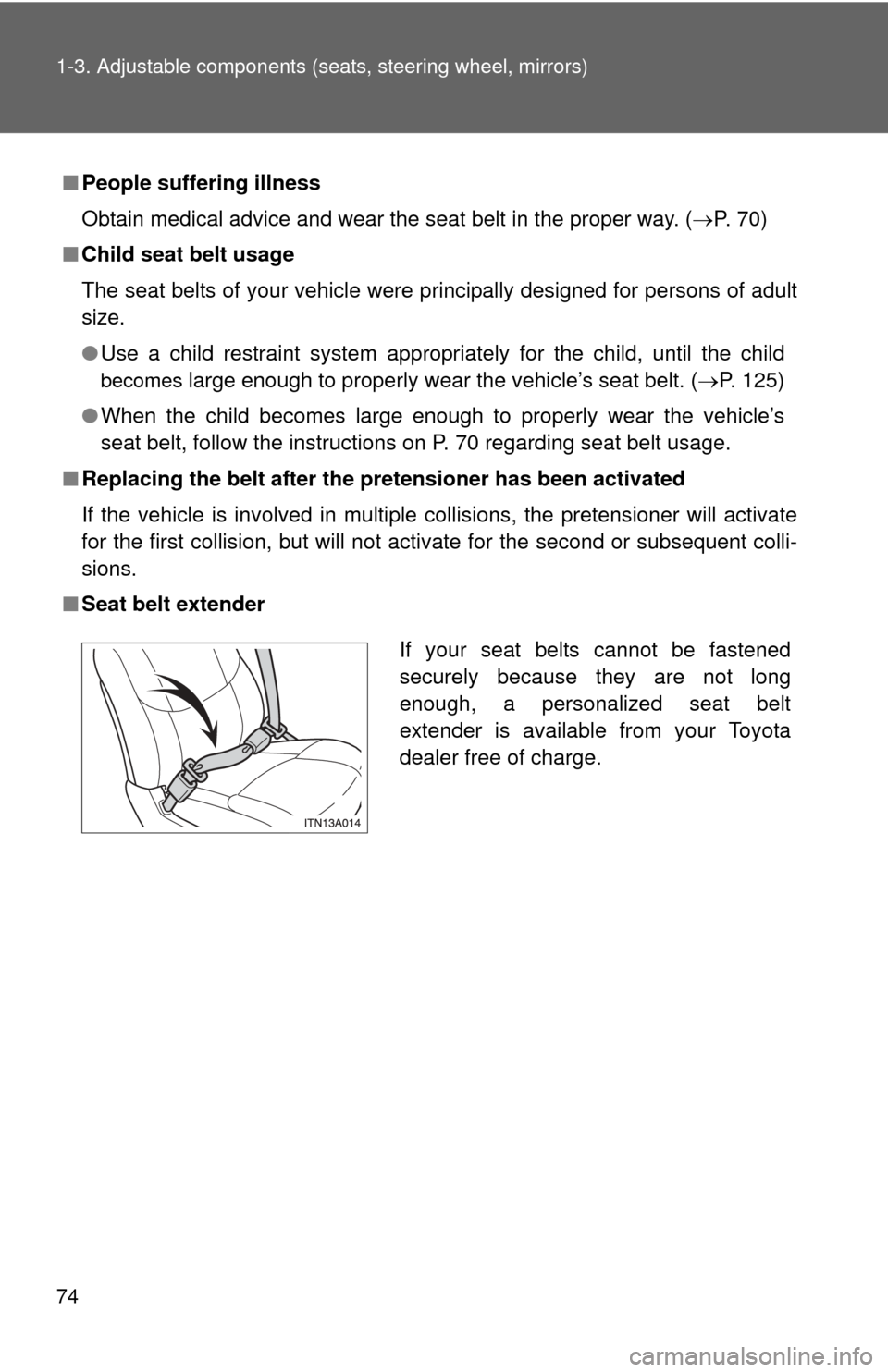
74 1-3. Adjustable components (seats, steering wheel, mirrors)
■People suffering illness
Obtain medical advice and wear the seat belt in the proper way. ( P. 70)
■ Child seat belt usage
The seat belts of your vehicle were principally designed for persons of adult
size.
●Use a child restraint system appropriately for the child, until the child
becomes large enough to properly wear the vehicle’s seat belt. ( P. 125)
● When the child becomes large enough to properly wear the vehicle’s
seat belt, follow the instructions on P. 70 regarding seat belt usage.
■ Replacing the belt after the pretensioner has been activated
If the vehicle is involved in multiple collisions, the pretensioner will activate
for the first collision, but will not activate for the second or subsequent colli-
sions.
■ Seat belt extender
If your seat belts cannot be fastened
securely because they are not long
enough, a personalized seat belt
extender is available from your Toyota
dealer free of charge.
Page 77 of 580
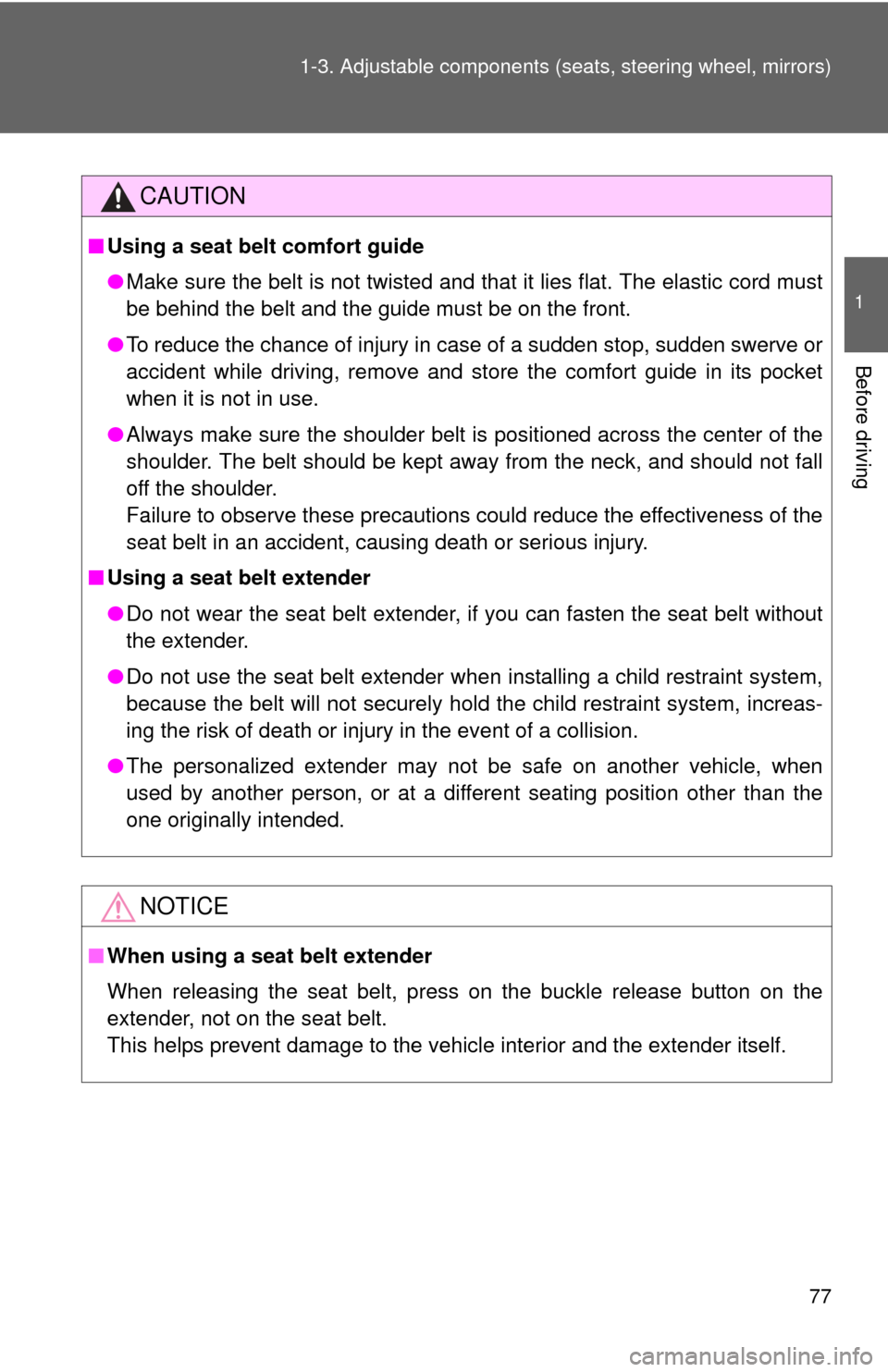
77
1-3. Adjustable components (seat
s, steering wheel, mirrors)
1
Before driving
CAUTION
■Using a seat belt comfort guide
●Make sure the belt is not twisted and that it lies flat. The elastic cord must
be behind the belt and the guide must be on the front.
● To reduce the chance of injury in case of a sudden stop, sudden swerve or\
accident while driving, remove and store the comfort guide in its pocket
when it is not in use.
● Always make sure the shoulder belt is positioned across the center of the
shoulder. The belt should be kept away from the neck, and should not fall
off the shoulder.
Failure to observe these precautions could reduce the effectiveness of the
seat belt in an accident, causing death or serious injury.
■ Using a seat belt extender
●Do not wear the seat belt extender, if you can fasten the seat belt without
the extender.
● Do not use the seat belt extender when installing a child restraint system,
because the belt will not securely hold the child restraint system, increas-
ing the risk of death or injury in the event of a collision.
● The personalized extender may not be safe on another vehicle, when
used by another person, or at a different seating position other than the
one originally intended.
NOTICE
■When using a seat belt extender
When releasing the seat belt, press on the buckle release button on the
extender, not on the seat belt.
This helps prevent damage to the vehicle interior and the extender itself.
Page 78 of 580
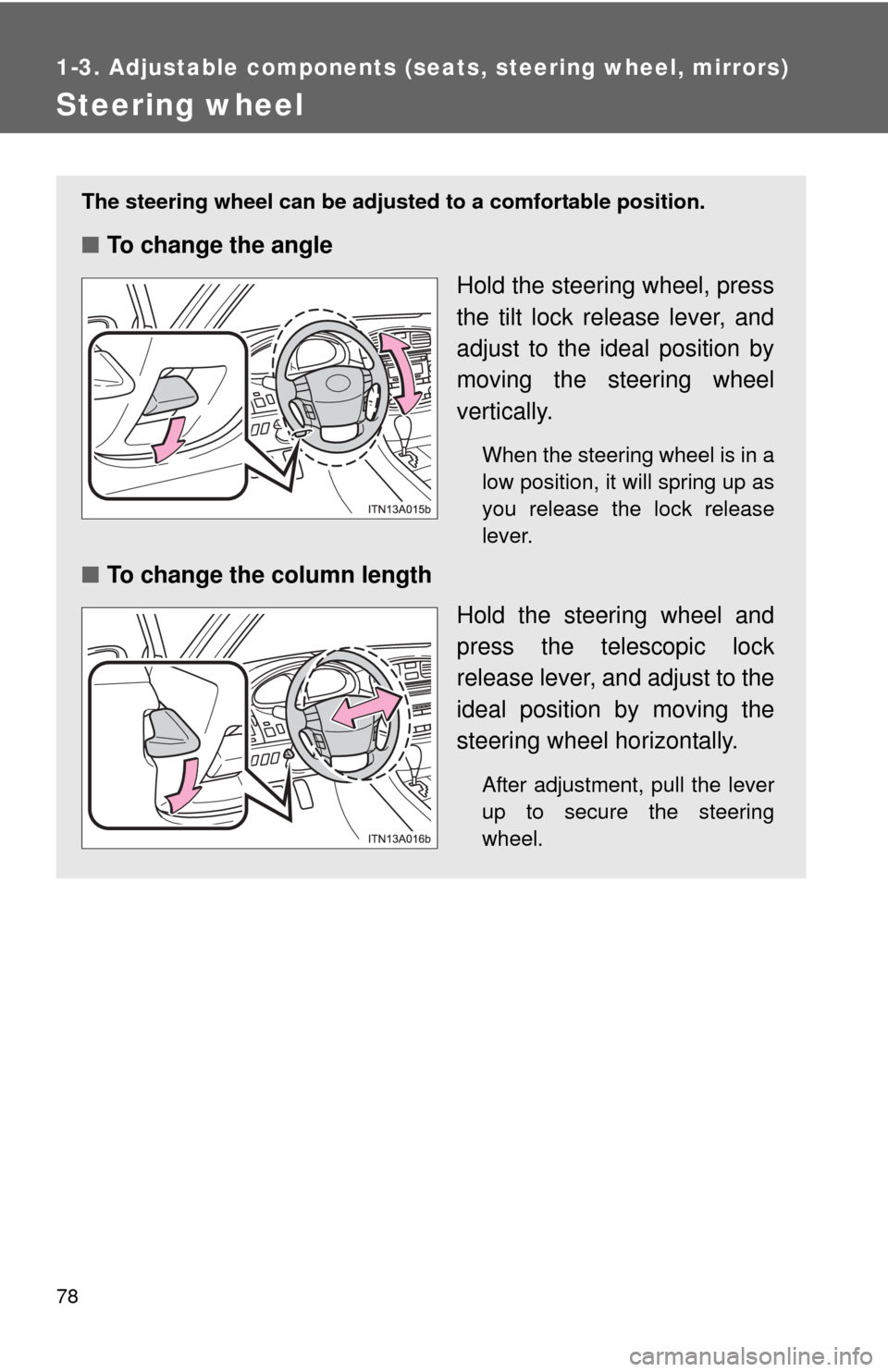
78
1-3. Adjustable components (seats, steering wheel, mirrors)
Steering wheel
The steering wheel can be adjusted to a comfortable position.
■To change the angle
Hold the steering wheel, press
the tilt lock release lever, and
adjust to the ideal position by
moving the steering wheel
vertically.
When the steering wheel is in a
low position, it will spring up as
you release the lock release
lever.
■To change the column length
Hold the steering wheel and
press the telescopic lock
release lever, and adjust to the
ideal position by moving the
steering wheel horizontally.
After adjustment, pull the lever
up to secure the steering
wheel.
Page 97 of 580
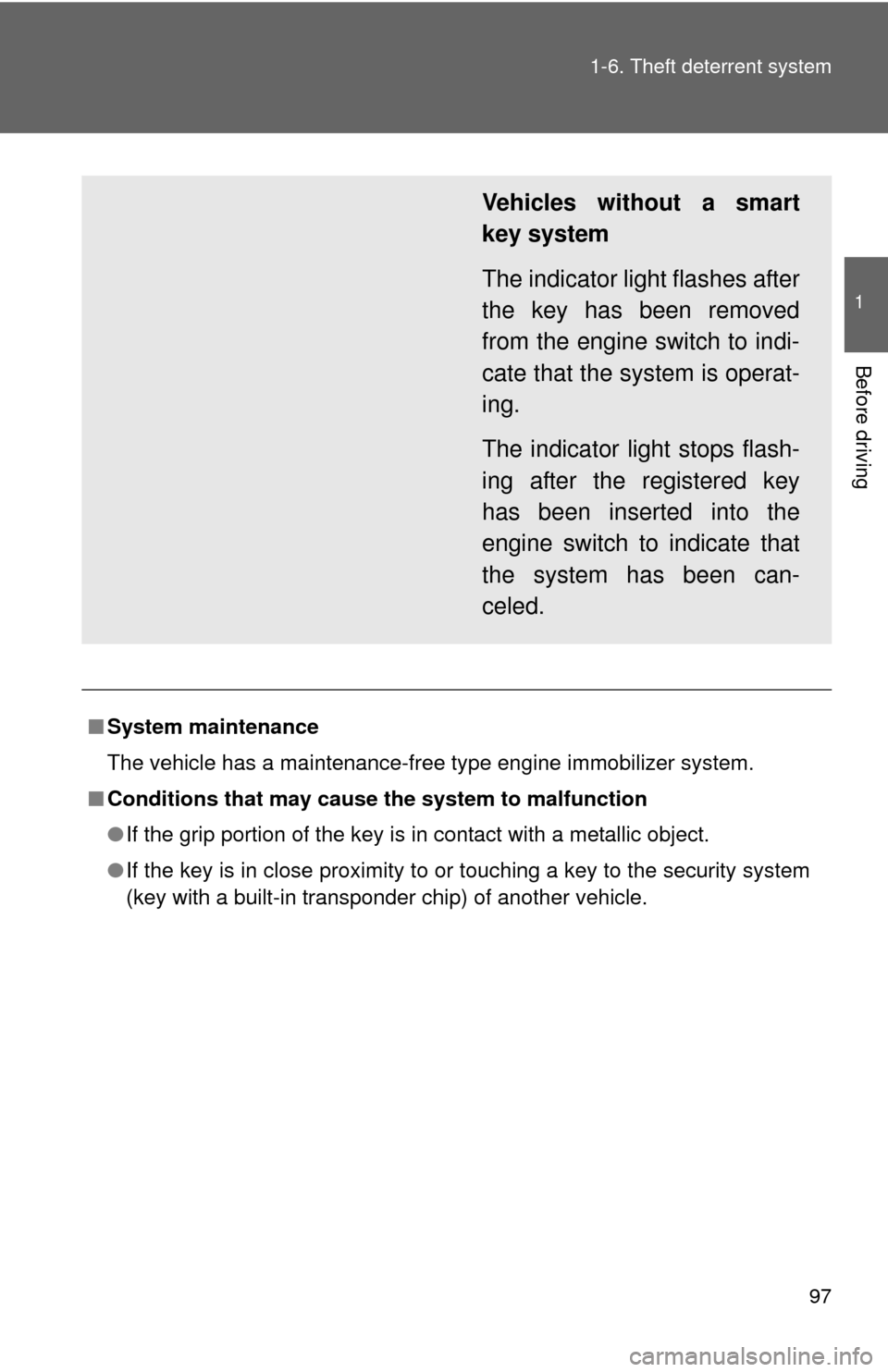
97
1-6. Theft deterrent system
1
Before driving
■
System maintenance
The vehicle has a maintenance-free type engine immobilizer system.
■ Conditions that may cause the system to malfunction
● If the grip portion of the key is in contact with a metallic object.
● If the key is in close proximity to or touching a key to the security system
(key with a built-in transponder chip) of another vehicle.
Vehicles without a smart
key system
The indicator light flashes after
the key has been removed
from the engine switch to indi-
cate that the system is operat-
ing.
The indicator light stops flash-
ing after the registered key
has been inserted into the
engine switch to indicate that
the system has been can-
celed.
Page 107 of 580
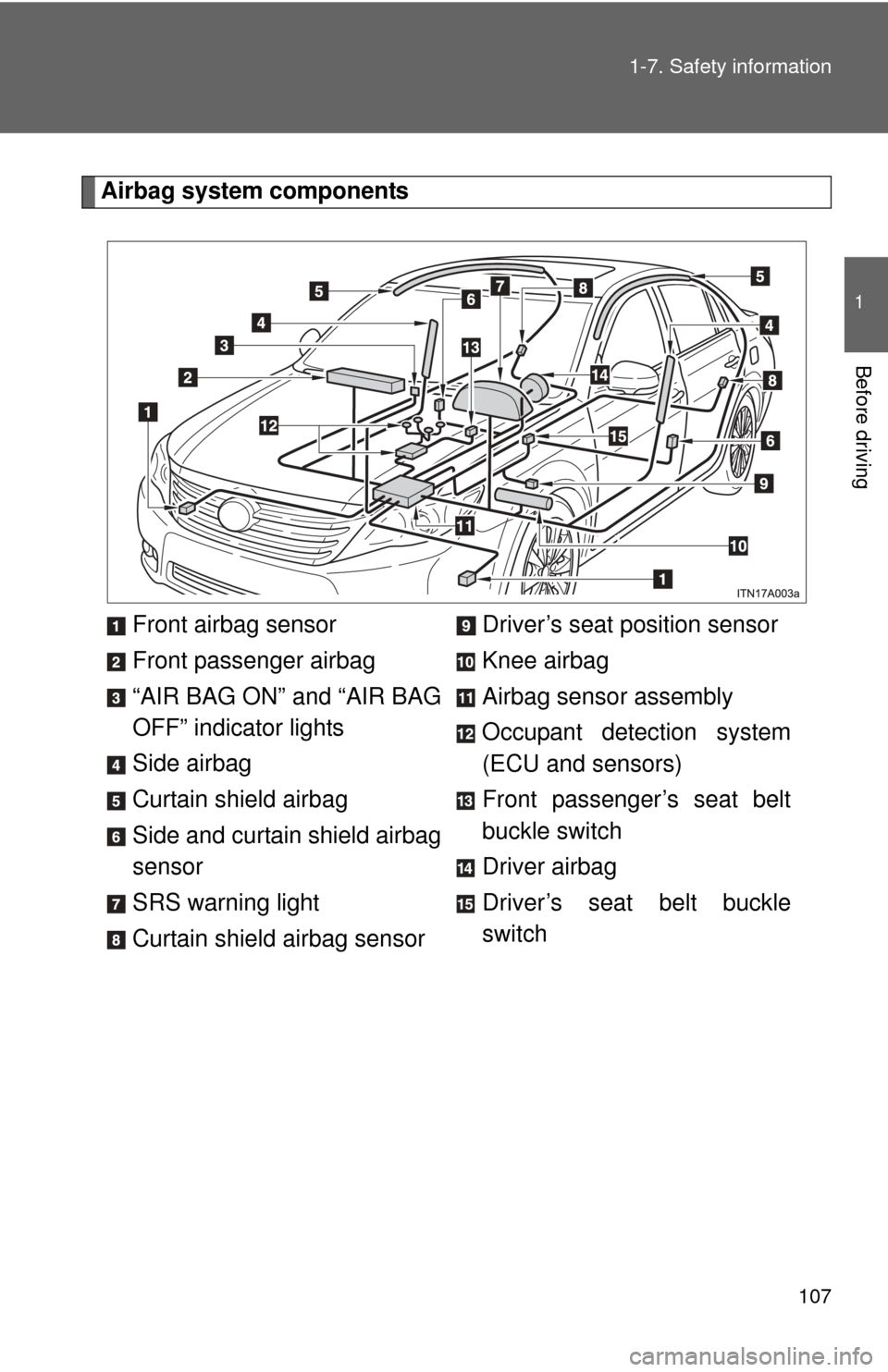
107
1-7. Safety information
1
Before driving
Airbag system components
Front airbag sensor
Front passenger airbag
“AIR BAG ON” and “AIR BAG
OFF” indicator lights
Side airbag
Curtain shield airbag
Side and curtain shield airbag
sensor
SRS warning light
Curtain shield airbag sensor Driver’s seat position sensor
Knee airbag
Airbag sensor assembly
Occupant detection system
(ECU and sensors)
Front passenger’s seat belt
buckle switch
Driver airbag
Driver’s seat belt buckle
switch
Page 114 of 580
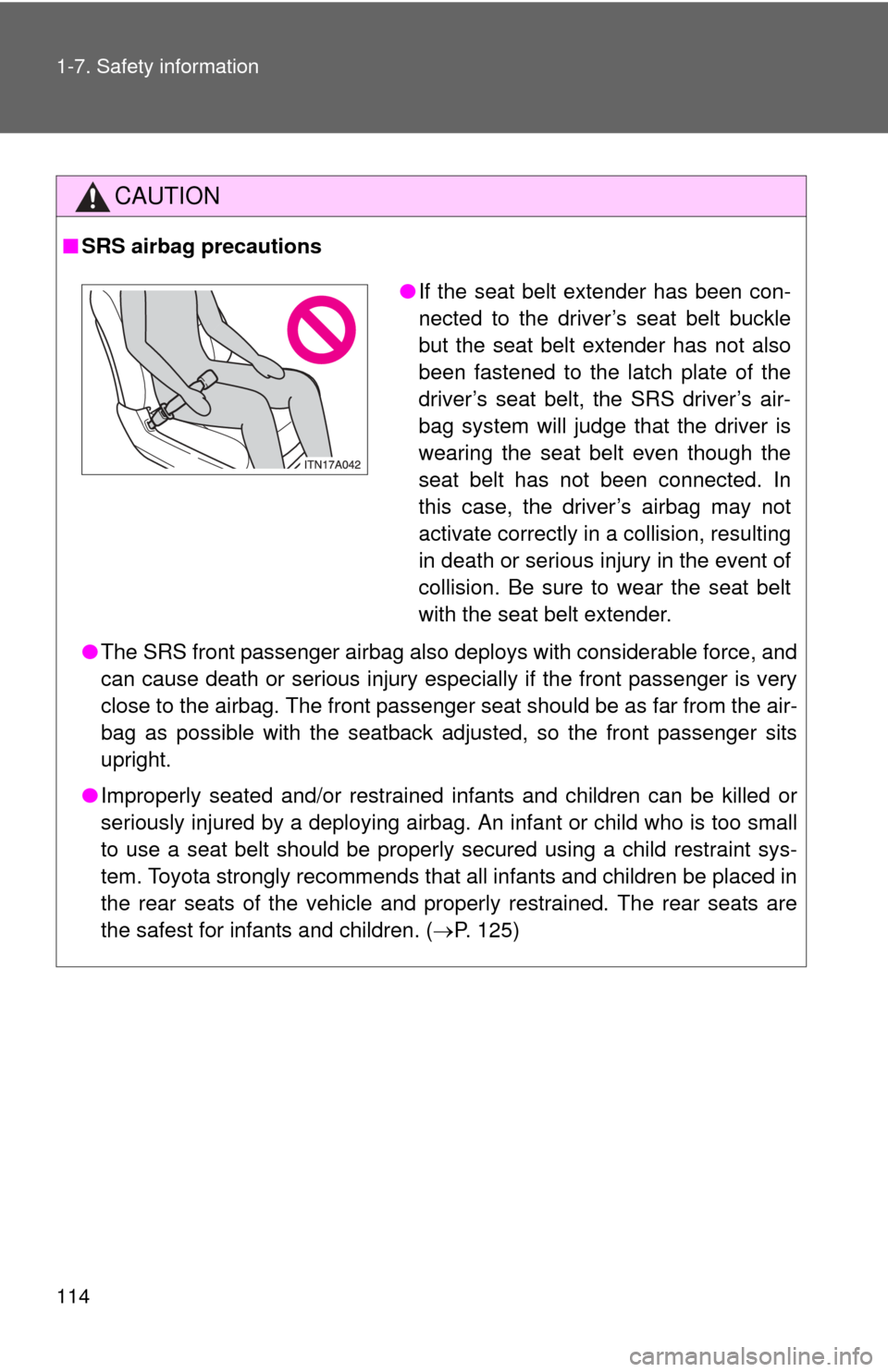
114 1-7. Safety information
CAUTION
■SRS airbag precautions
●The SRS front passenger airbag also deploys with considerable force, and
can cause death or serious injury especially if the front passenger is very
close to the airbag. The front passenger seat should be as far from the air-
bag as possible with the seatback adjusted, so the front passenger sits
upright.
● Improperly seated and/or restrained in fants and children can be killed or
seriously injured by a deploying airbag. An infant or child who is too small
to use a seat belt should be properly secured using a child restraint sys-
tem. Toyota strongly recommends that all infants and children be placed in
the rear seats of the vehicle and properly restrained. The rear seats are
the safest for infants and children. ( P. 125)
●If the seat belt extender has been con-
nected to the driver’s seat belt buckle
but the seat belt extender has not also
been fastened to the latch plate of the
driver’s seat belt, the SRS driver’s air-
bag system will judge that the driver is
wearing the seat belt even though the
seat belt has not been connected. In
this case, the driver’s airbag may not
activate correctly in a collision, resulting
in death or serious injury in the event of
collision. Be sure to wear the seat belt
with the seat belt extender.